Exploring the Food of Arab Culture
Download as pptx, pdf16 likes15,724 views
This document provides an overview of traditional foods in Arabic culture, including desserts, main dishes, and sides. It describes several popular desserts that commonly feature homemade syrup and nuts, such as baklava and knafe. Main dishes highlighted include hummus, falafel, stuffed grape leaves, labneh, and makloubeh. Couscous and shawarma are also mentioned as staple foods. The document conveys that while recipes may vary slightly between regions, the core ingredients remain consistent across Arabic cuisine.
1 of 16
Downloaded 424 times
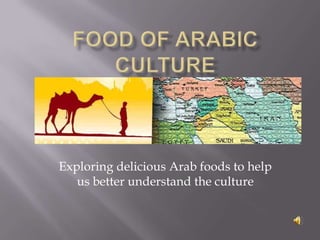
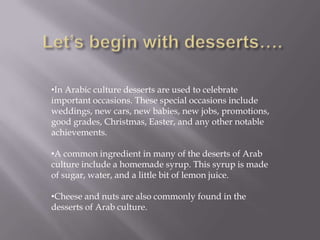


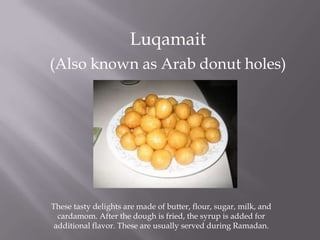
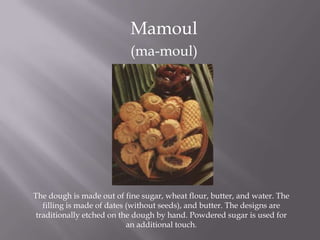
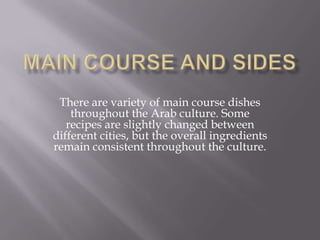

![Hummus[hoom-uhs] The main ingredient in hummus is chickpeas. The chickpeas are ground and mixed with lemon juice, oil, and garlic. Hummus can be served as an appetizer or side and usually accompanied by pita bread.](https://image.slidesharecdn.com/arabfood-100405234552-phpapp02/85/Exploring-the-Food-of-Arab-Culture-9-320.jpg)
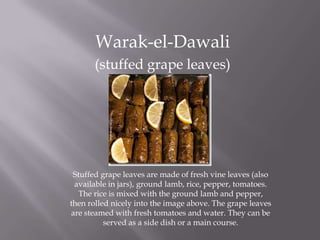

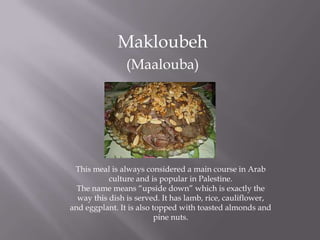
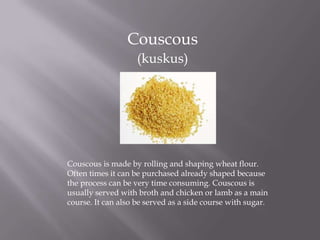


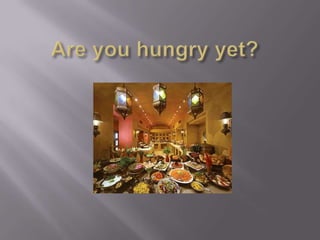
Ad
Recommended
lebanese cusine and culture
lebanese cusine and culturepptsaresilly
╠²
Lebanese cuisine has been influenced by its Mediterranean coastline and traders from ancient civilizations like the Phoenicians, Egyptians, Persians, Greeks, Romans, Crusaders, French and Ottomans. Common ingredients include wheat, rice, meat, seafood, vegetables, dairy, nuts, and fresh herbs. Popular dishes include flatbread, mezze, baba ghanoush, shish taouk, falafel, and kibbeh. Recent food trends in Lebanon include the rise of Asian and Brazilian restaurants and increased awareness of reducing food waste.Spanish cuisine
Spanish cuisine lipika Chhabra
╠²
Paella is a rice dish originating in Valencia, Spain. It traditionally contains rice, chicken, rabbit, snails, beans and artichokes. The rice is cooked in a flat pan over an open fire with saffron added, which gives it a golden color. Jamon is Spanish cured ham, which comes in two varieties - serrano from the mountains and higher quality iberico from black Iberian pigs. The hams are salted, dried and aged for several months. Tortillas are flat, round breads from Mexico made of corn or wheat flour. They can be eaten plain or used to wrap fillings for burritos, tacos and other dishes.Greek cuisine
Greek cuisineRoger Alair
╠²
Greek cuisine is a Mediterranean culinary tradition characterized by its use of olive oil, vegetables, grains, and a variety of meats. It has evolved over thousands of years, influenced by various cultures including the Romans, Byzantines, and Ottomans, leading to a diverse range of regional dishes and flavors. Typical dishes include Greek salad, spanakopita, moussaka, and numerous seafood and dessert options, reflecting a rich history of blending culinary practices.Cultural foods in the middle east
Cultural foods in the middle east Oscar Co
╠²
The document discusses the foods and cuisines of several Middle Eastern countries including Afghanistan, Armenia, Azerbaijan, Bahrain, Georgia, Iran, Iraq, Israel, and Jordan. The cuisines are characterized by spices like cinnamon, coriander, and turmeric and ingredients like olive oil, chickpeas, yogurt, and grains. Popular dishes mentioned include falafel, dolma, shish kebabs, and stews made with lamb, beef, or chicken. Religious dietary restrictions like halal and kosher influence the foods that are commonly eaten.Mediterranean Cuisine
Mediterranean CuisineAiccel Dela Cruz
╠²
The Mediterranean is located between Europe, Africa, and Asia. It has a mild climate and has historically been an important trade route. The cuisine of Mediterranean countries has been influenced by many ancient civilizations and is known for its use of olive oil, grains, vegetables, fruits, herbs, seafood, and red wine consumed in moderation. Key characteristics include fresh, simple ingredients and sharing meals with others. The Greek and Turkish cuisines both reflect Mediterranean influences and make significant use of ingredients like olive oil, garlic, onions, lentils, rice, yogurt, breads, and seafood.Greek Cuisine
Greek CuisineNIKOS KARRAS
╠²
Greek cuisine is a Mediterranean cuisine that has been passed down through generations. It is influenced by Greece's geography, with dishes changing depending on the season and between coastal and mountainous areas. Food and social interaction are deeply ingrained in Greek culture, with meals bringing families and communities together for important events. The traditional Greek diet centers around the Mediterranean triad of wheat, olive oil, and wine, along with foods produced by small farmers like cheeses, oils, fruits, nuts, grains, vegetables, and herbs. With over 20% of Greece made up of islands, seafood is also a staple. Dishes include bean soups, pies, salads like Greek salad, tzatziki, and main dishes of meatFAMOUS INDIAN SWEETS
FAMOUS INDIAN SWEETSBrahmas Pandey
╠²
Indian sweets are a diverse collection of desserts that have developed over thousands of years across the Indian subcontinent. Sugarcane was domesticated in India and used to make sweets. There are countless varieties of Indian sweets that use ingredients like milk, yogurt, rice, lentils, nuts, and seasonal fruits. Sweets are an important part of Indian culture, featured in celebrations, religious ceremonies, and acts of hospitality. Some popular Indian sweets mentioned include gulab jamun, jalebi, barfi, kulfi, and laddu.French Cuisine
French Cuisineseamuse1998
╠²
The document summarizes key aspects of French cuisine, including that the French enjoy foods like escargot and frog's legs. Presentation of food is also important in French cuisine. French meals typically have four parts and lunches last at least two hours. Wines are as important as meals to the French. Some additional facts provided are that crêpes originated from Brittany, France produces over 400 types of cheeses and more than 1,000 varieties can be found in stores, and hot chocolate is popular though the French drink it from bowls.Asian cuisine
Asian cuisineMarjolaine Delos Reyes
╠²
Middle Eastern cuisine developed over thousands of years in the Fertile Crescent region, with influences from ancient civilizations, religions, and later empires. Core foods include wheat, rice, lamb, yogurt, and bread. Popular dishes are hummus, baba ghanoush, falafel, and shawarma, while desserts include baklava. Religious influences like Islam impact the cuisine through prohibitions on pork and alcohol. Meals are often built around mezze appetizers and eaten with flatbread.French classical menu
French classical menuSASIKUMAR NATARAJAN
╠²
The document provides an overview of the French classical menu, detailing its structure of 12 to 17 courses that include a variety of appetizers, soups, fish, meats, and desserts. Each course is briefly described along with examples, illustrating the traditional sequence and types of dishes served in French dining. Key components such as hors d'oeuvres, potages, entrees, and desserts highlight the diverse culinary techniques and ingredients characteristic of French cuisine.Herbs & spices knowledge/ chefqtrainer.blogspot.com
Herbs & spices knowledge/ chefqtrainer.blogspot.com Culinary Training Program
╠²
This document provides information on various herbs and spices. It defines herbs as leaves, stems or flowers of aromatic plants that can be used fresh or dried. Spices are defined as aromatic plant bark, roots, seeds, buds or berries that are usually dried. The document then proceeds to describe the properties and common uses of over 20 individual herbs and spices, including basil, bay leaves, chives, cilantro, dill, mint, lemon grass, oregano, parsley, thyme, rosemary, sage and tarragon among the herbs and allspice, caraway, cumin, ginger, nutmeg, paprika, peppercorn, poppy seeds, saffron and sesame seeds among the spices.French-Cuisine.pptx
French-Cuisine.pptxJomarieRamirez2
╠²
This document provides information about French cuisine, including its history, characteristics, regional cuisines, influences, differences between nouvelle cuisine and haute cuisine, and popular French dishes. It discusses how French cuisine originated in France and is characterized by rich and flavorful ingredients balanced with butter, cream, herbs and spices. It also outlines the historical development of French cooking from medieval times to modern haute cuisine.French classical menu
French classical menuRavi Dandotiya
╠²
The document provides details on the courses that make up a traditional French classical menu, including:
1) Hors d'oeuvres which are appetizers served before the meal, including seafood cocktails, grapes, melon, and caviar.
2) Soups which can be thick or thin, and are served with bread.
3) Eggs dishes like omelettes.
4) Pasta and rice dishes like spaghetti and risotto.
5) Fish courses featuring dishes like salmon and sole.
6) Entrees which are smaller meat dishes served before the main course.
7) Sorbet which provides palate cleansing between courses.
8) MainAsian cuisine
Asian cuisineMillbrook Fccla
╠²
Asian cuisine can be categorized into East Asian and Southeast Asian regions. Common equipment used includes woks, steamers, cleavers, and rice cookers. Key flavor profiles include soy sauce, sake, mirin, rice vinegar, fish sauce, and ingredients like scallion, garlic, and ginger. Popular cooking techniques are shallow frying, stir frying, and steaming.National soups of different countries
National soups of different countries Somitra Upadhyay
╠²
The document provides an overview of various national soups from different countries, detailing their main ingredients. Examples include Italy's minestrone, France's French onion soup, and Japan's miso soup, each with unique components. The classification of soups is also mentioned, differentiating between clear and thick soups.Chinese cuisine
Chinese cuisineMohammad Abdullah
╠²
The document provides an overview of Chinese cuisine, including its diverse styles that vary by region. It notes that Chinese cuisine is one of the most diverse in the world, with rice as the staple food. Key regional cuisines include Peking style from the northern region, known for wheat and millet; Cantonese style from the south, featuring seafood and rice; Shanghai style along the eastern coast; and Szechuan style from the western region, characterized by its use of spices and chilies. Common ingredients include tofu, noodles, soy sauce, mushrooms, and five-spice powder. Popular dishes include dim sum, hot pot, Peking duck, and sweet and sour pork. Woks, cleaThai cuisine
Thai cuisineMohammad Abdullah
╠²
Thai cuisine is influenced by its geographical location at the crossroads of Asia. It uses ingredients like lemongrass, kaffir lime, and bird's eye chillies in curries and other dishes that balance spicy, sweet, and sour flavors. Thai cuisine is divided into regional styles from the north, northeast, central, and south regions, each utilizing local ingredients and cooking methods. Common dishes include curries, salads, stir fries and noodles that feature seafood, meat, vegetables, herbs, and spices characteristic of Thai cooking. A variety of tools and equipment are used in preparing traditional Thai dishes.Cuisine
CuisineSophia Moore
╠²
European cuisine refers collectively to the cuisines of Europe and other Western countries. It is influenced by regional climate and settles into three main types: Eastern, Southern, and Western. Western European cuisine is the most diverse and includes the cuisines of countries like France, Belgium, Luxembourg, the Netherlands, and others. It is characterized by prominent meat servings and wine. Central European cuisine encompasses the cuisines of countries like Germany, Austria, Switzerland, the Czech Republic, Hungary, Slovakia, Poland and others. Eastern European cuisine shows similarities between countries like Russia, Ukraine, Belarus, but differs from Caucasian cuisine. It is strongly influenced by climate and still varies by country.Italian food
Italian foodSAJAN SANJEL
╠²
Italian cuisine originated in Italy and has influenced many other Western cuisines. The geography of Italy, with its variety of ingredients grown locally, has played a role in the evolution of Italian regional cuisines. Some key regions include Tuscany, known for bread, pasta, and wine, and Campania, known for pizza, tomatoes, and pasta. Popular ingredients in Italian cuisine include cheeses like Parmesan and ricotta, olive oil, starches like rice and polenta, and pasta. Iconic dishes include pizza, minestrone soup, and gelato ice cream. Traditional Italian meals usually involve courses like appetizers, primi of pasta or rice, secondi of meat or fish, with wine and espressFood and drinks
Food and drinksmarilize2
╠²
This document lists various foods, vegetables, fruits and drinks categorized into sections. It includes a wide variety of fruits like apples, grapes, blackberries and avocado. Vegetables mentioned are asparagus, broccoli, cabbage, carrots and more. Fast foods listed are pizza, hamburgers, chips and hot dogs. Various drinks are also noted such as coke, water, milk and different juices. The document was created by Beatriz Torres no6 and marks the end of the listing. FOOD AROUND THE WORLD....ENGLISH PROJECT
FOOD AROUND THE WORLD....ENGLISH PROJECT#MesueseAurela Elezaj
╠²
The document introduces traditional foods from various continents, highlighting the unique characteristics and influences on each cuisine. It details European, American, Asian, African, and Australian cuisines, emphasizing regional specialties, local ingredients, and cooking traditions. Additionally, it notes the fusion of different culinary styles, particularly in American and Asian cuisines, showcasing the diversity of global culinary practices.Breakfast
Breakfastvikesh Kashyap
╠²
The document discusses different types of breakfasts including English, American, Continental, Indian, and buffet breakfasts. It provides details on the typical food items included and table settings for an English breakfast, which features meat items like fish, eggs, bacon and sausages along with juices, fruits, cereals and breads. An American breakfast is similar but does not include fish. A Continental breakfast more simply includes breads, butter, preserves and coffee or tea. Indian breakfast varies regionally but can include dishes like idli sambhar in the south. Related terms for types of breakfast service are also defined.Common culinary herbs and spices
Common culinary herbs and spicesMelchor Lanuzo
╠²
The document provides an overview of common culinary herbs and spices, offering guidance on purchasing, storing, and using them to enhance vegan dishes. It highlights various herbs and spices, detailing their flavor profiles, culinary applications, and tips for incorporation into recipes. The document serves as a resource for those seeking to expand their cooking with global spice and herb varieties.ENGLISH BREAKFAST
ENGLISH BREAKFAST indian chefrecipe
╠²
An English breakfast consists of a variety of dishes from which guests can choose including fresh juices, stewed fruits, cereals, eggs cooked in different styles, smoked fish or meat, breads, and beverages like coffee and tea. Setting up an English breakfast involves having the proper plates, utensils, and accompaniments like preserves, sugar, and a bud vase on the table.Mediterranean cuisine
Mediterranean cuisinetushu12
╠²
Mediterranean cuisine originated from cultures surrounding the Mediterranean Sea. Though diverse, the region shares common elements due to climate and trade, including plant-based diets featuring olive oil, fruits/vegetables, legumes, fish, and grains. The cuisine developed over millennia and was popularized in the 20th century for its health benefits like low saturated fat and high fiber content. Key ingredients include olive oil, tomatoes, eggplant, chickpeas, couscous, broccoli rabe, hazelnuts, and shrimp.Indian Basic commodities and usage in Indian cooking TechniquesŌĆ©
Indian Basic commodities and usage in Indian cooking TechniquesŌĆ©susanta kumar mishra
╠²
This document discusses basic ingredients and cooking techniques used in Indian cuisine. It outlines various herbs and spices that are the backbone of Indian cooking, including bay leaves, cinnamon, cumin, mint and coriander. It also describes common Indian gravies like makhani, brown, white and yellow gravy and what ingredients are used to make each. Additional sections cover tenderizing agents, thickening agents, classic kebabs, Indian breads and popular Indian desserts.Food in the Arabic Culture Presentation
Food in the Arabic Culture PresentationMarwa Thabet
╠²
This document discusses food in the Arabic culture. It aims to teach students 10 components of the Arabic nutrition pyramid and 3 popular Arabic dishes. The document begins by outlining the learning objectives. It then shows a video to help students identify words related to the nutrition pyramid categories like carbohydrates, vegetables, fruits, fat, milk, and proteins. The document also presents the names of popular Arabic dishes like Koshary, Dolma, Shawerma, and Baklava. It asks students to discuss which of these dishes would most appeal to American tastes and why.Our italian cuisine Erasmus+
Our italian cuisine Erasmus+Escola Països Catalans
╠²
Italian cuisine varies widely by region but is characterized by fresh, seasonal ingredients. Common northern Italian dishes rely on butter, meat and potatoes while southern cuisine uses more olive oil, tomatoes, vegetables and fish. Italian meals typically include a first course like pasta or soup, a second course of meat or fish with vegetables, and are eaten slowly with family or friends. Traditional Italian dishes also vary by festival, with Christmas featuring dishes like timballo and Easter including lamb dishes and Easter eggs.Kuwait Country PowerPoint Presentation Content
Kuwait Country PowerPoint Presentation ContentAndrew Schwartz
╠²
The document provides information about various aspects of life in Kuwait, including family life, social and business etiquette, and trivia. It highlights the participation of Kuwaiti women in the labor force, the importance of respecting elders, and the country's political history. Additionally, it offers a downloadable presentation with detailed content covering general information, food and etiquette, and other cultural insights.Kuwait
KuwaitVinod Raj
╠²
Kuwait has a population of 4.1 million and its regulatory authority is the State of Kuwait drug and food control administration. The Kuwaiti pharmaceutical market was valued at $781 million in 2012 and is dominated by imported drugs. Major pharmaceutical companies in Kuwait include the Kuwait Saudi Pharmaceutical Industries Company, Sanofi Aventis, and Yiaco Pharmaceuticals. Registration of pharmaceutical products in Kuwait requires documents such as certificates of pharmaceutical product, price, and GMP as well as stability studies, bioequivalence studies, and clinical data.More Related Content
What's hot (20)
Asian cuisine
Asian cuisineMarjolaine Delos Reyes
╠²
Middle Eastern cuisine developed over thousands of years in the Fertile Crescent region, with influences from ancient civilizations, religions, and later empires. Core foods include wheat, rice, lamb, yogurt, and bread. Popular dishes are hummus, baba ghanoush, falafel, and shawarma, while desserts include baklava. Religious influences like Islam impact the cuisine through prohibitions on pork and alcohol. Meals are often built around mezze appetizers and eaten with flatbread.French classical menu
French classical menuSASIKUMAR NATARAJAN
╠²
The document provides an overview of the French classical menu, detailing its structure of 12 to 17 courses that include a variety of appetizers, soups, fish, meats, and desserts. Each course is briefly described along with examples, illustrating the traditional sequence and types of dishes served in French dining. Key components such as hors d'oeuvres, potages, entrees, and desserts highlight the diverse culinary techniques and ingredients characteristic of French cuisine.Herbs & spices knowledge/ chefqtrainer.blogspot.com
Herbs & spices knowledge/ chefqtrainer.blogspot.com Culinary Training Program
╠²
This document provides information on various herbs and spices. It defines herbs as leaves, stems or flowers of aromatic plants that can be used fresh or dried. Spices are defined as aromatic plant bark, roots, seeds, buds or berries that are usually dried. The document then proceeds to describe the properties and common uses of over 20 individual herbs and spices, including basil, bay leaves, chives, cilantro, dill, mint, lemon grass, oregano, parsley, thyme, rosemary, sage and tarragon among the herbs and allspice, caraway, cumin, ginger, nutmeg, paprika, peppercorn, poppy seeds, saffron and sesame seeds among the spices.French-Cuisine.pptx
French-Cuisine.pptxJomarieRamirez2
╠²
This document provides information about French cuisine, including its history, characteristics, regional cuisines, influences, differences between nouvelle cuisine and haute cuisine, and popular French dishes. It discusses how French cuisine originated in France and is characterized by rich and flavorful ingredients balanced with butter, cream, herbs and spices. It also outlines the historical development of French cooking from medieval times to modern haute cuisine.French classical menu
French classical menuRavi Dandotiya
╠²
The document provides details on the courses that make up a traditional French classical menu, including:
1) Hors d'oeuvres which are appetizers served before the meal, including seafood cocktails, grapes, melon, and caviar.
2) Soups which can be thick or thin, and are served with bread.
3) Eggs dishes like omelettes.
4) Pasta and rice dishes like spaghetti and risotto.
5) Fish courses featuring dishes like salmon and sole.
6) Entrees which are smaller meat dishes served before the main course.
7) Sorbet which provides palate cleansing between courses.
8) MainAsian cuisine
Asian cuisineMillbrook Fccla
╠²
Asian cuisine can be categorized into East Asian and Southeast Asian regions. Common equipment used includes woks, steamers, cleavers, and rice cookers. Key flavor profiles include soy sauce, sake, mirin, rice vinegar, fish sauce, and ingredients like scallion, garlic, and ginger. Popular cooking techniques are shallow frying, stir frying, and steaming.National soups of different countries
National soups of different countries Somitra Upadhyay
╠²
The document provides an overview of various national soups from different countries, detailing their main ingredients. Examples include Italy's minestrone, France's French onion soup, and Japan's miso soup, each with unique components. The classification of soups is also mentioned, differentiating between clear and thick soups.Chinese cuisine
Chinese cuisineMohammad Abdullah
╠²
The document provides an overview of Chinese cuisine, including its diverse styles that vary by region. It notes that Chinese cuisine is one of the most diverse in the world, with rice as the staple food. Key regional cuisines include Peking style from the northern region, known for wheat and millet; Cantonese style from the south, featuring seafood and rice; Shanghai style along the eastern coast; and Szechuan style from the western region, characterized by its use of spices and chilies. Common ingredients include tofu, noodles, soy sauce, mushrooms, and five-spice powder. Popular dishes include dim sum, hot pot, Peking duck, and sweet and sour pork. Woks, cleaThai cuisine
Thai cuisineMohammad Abdullah
╠²
Thai cuisine is influenced by its geographical location at the crossroads of Asia. It uses ingredients like lemongrass, kaffir lime, and bird's eye chillies in curries and other dishes that balance spicy, sweet, and sour flavors. Thai cuisine is divided into regional styles from the north, northeast, central, and south regions, each utilizing local ingredients and cooking methods. Common dishes include curries, salads, stir fries and noodles that feature seafood, meat, vegetables, herbs, and spices characteristic of Thai cooking. A variety of tools and equipment are used in preparing traditional Thai dishes.Cuisine
CuisineSophia Moore
╠²
European cuisine refers collectively to the cuisines of Europe and other Western countries. It is influenced by regional climate and settles into three main types: Eastern, Southern, and Western. Western European cuisine is the most diverse and includes the cuisines of countries like France, Belgium, Luxembourg, the Netherlands, and others. It is characterized by prominent meat servings and wine. Central European cuisine encompasses the cuisines of countries like Germany, Austria, Switzerland, the Czech Republic, Hungary, Slovakia, Poland and others. Eastern European cuisine shows similarities between countries like Russia, Ukraine, Belarus, but differs from Caucasian cuisine. It is strongly influenced by climate and still varies by country.Italian food
Italian foodSAJAN SANJEL
╠²
Italian cuisine originated in Italy and has influenced many other Western cuisines. The geography of Italy, with its variety of ingredients grown locally, has played a role in the evolution of Italian regional cuisines. Some key regions include Tuscany, known for bread, pasta, and wine, and Campania, known for pizza, tomatoes, and pasta. Popular ingredients in Italian cuisine include cheeses like Parmesan and ricotta, olive oil, starches like rice and polenta, and pasta. Iconic dishes include pizza, minestrone soup, and gelato ice cream. Traditional Italian meals usually involve courses like appetizers, primi of pasta or rice, secondi of meat or fish, with wine and espressFood and drinks
Food and drinksmarilize2
╠²
This document lists various foods, vegetables, fruits and drinks categorized into sections. It includes a wide variety of fruits like apples, grapes, blackberries and avocado. Vegetables mentioned are asparagus, broccoli, cabbage, carrots and more. Fast foods listed are pizza, hamburgers, chips and hot dogs. Various drinks are also noted such as coke, water, milk and different juices. The document was created by Beatriz Torres no6 and marks the end of the listing. FOOD AROUND THE WORLD....ENGLISH PROJECT
FOOD AROUND THE WORLD....ENGLISH PROJECT#MesueseAurela Elezaj
╠²
The document introduces traditional foods from various continents, highlighting the unique characteristics and influences on each cuisine. It details European, American, Asian, African, and Australian cuisines, emphasizing regional specialties, local ingredients, and cooking traditions. Additionally, it notes the fusion of different culinary styles, particularly in American and Asian cuisines, showcasing the diversity of global culinary practices.Breakfast
Breakfastvikesh Kashyap
╠²
The document discusses different types of breakfasts including English, American, Continental, Indian, and buffet breakfasts. It provides details on the typical food items included and table settings for an English breakfast, which features meat items like fish, eggs, bacon and sausages along with juices, fruits, cereals and breads. An American breakfast is similar but does not include fish. A Continental breakfast more simply includes breads, butter, preserves and coffee or tea. Indian breakfast varies regionally but can include dishes like idli sambhar in the south. Related terms for types of breakfast service are also defined.Common culinary herbs and spices
Common culinary herbs and spicesMelchor Lanuzo
╠²
The document provides an overview of common culinary herbs and spices, offering guidance on purchasing, storing, and using them to enhance vegan dishes. It highlights various herbs and spices, detailing their flavor profiles, culinary applications, and tips for incorporation into recipes. The document serves as a resource for those seeking to expand their cooking with global spice and herb varieties.ENGLISH BREAKFAST
ENGLISH BREAKFAST indian chefrecipe
╠²
An English breakfast consists of a variety of dishes from which guests can choose including fresh juices, stewed fruits, cereals, eggs cooked in different styles, smoked fish or meat, breads, and beverages like coffee and tea. Setting up an English breakfast involves having the proper plates, utensils, and accompaniments like preserves, sugar, and a bud vase on the table.Mediterranean cuisine
Mediterranean cuisinetushu12
╠²
Mediterranean cuisine originated from cultures surrounding the Mediterranean Sea. Though diverse, the region shares common elements due to climate and trade, including plant-based diets featuring olive oil, fruits/vegetables, legumes, fish, and grains. The cuisine developed over millennia and was popularized in the 20th century for its health benefits like low saturated fat and high fiber content. Key ingredients include olive oil, tomatoes, eggplant, chickpeas, couscous, broccoli rabe, hazelnuts, and shrimp.Indian Basic commodities and usage in Indian cooking TechniquesŌĆ©
Indian Basic commodities and usage in Indian cooking TechniquesŌĆ©susanta kumar mishra
╠²
This document discusses basic ingredients and cooking techniques used in Indian cuisine. It outlines various herbs and spices that are the backbone of Indian cooking, including bay leaves, cinnamon, cumin, mint and coriander. It also describes common Indian gravies like makhani, brown, white and yellow gravy and what ingredients are used to make each. Additional sections cover tenderizing agents, thickening agents, classic kebabs, Indian breads and popular Indian desserts.Food in the Arabic Culture Presentation
Food in the Arabic Culture PresentationMarwa Thabet
╠²
This document discusses food in the Arabic culture. It aims to teach students 10 components of the Arabic nutrition pyramid and 3 popular Arabic dishes. The document begins by outlining the learning objectives. It then shows a video to help students identify words related to the nutrition pyramid categories like carbohydrates, vegetables, fruits, fat, milk, and proteins. The document also presents the names of popular Arabic dishes like Koshary, Dolma, Shawerma, and Baklava. It asks students to discuss which of these dishes would most appeal to American tastes and why.Our italian cuisine Erasmus+
Our italian cuisine Erasmus+Escola Països Catalans
╠²
Italian cuisine varies widely by region but is characterized by fresh, seasonal ingredients. Common northern Italian dishes rely on butter, meat and potatoes while southern cuisine uses more olive oil, tomatoes, vegetables and fish. Italian meals typically include a first course like pasta or soup, a second course of meat or fish with vegetables, and are eaten slowly with family or friends. Traditional Italian dishes also vary by festival, with Christmas featuring dishes like timballo and Easter including lamb dishes and Easter eggs.Viewers also liked (11)
Kuwait Country PowerPoint Presentation Content
Kuwait Country PowerPoint Presentation ContentAndrew Schwartz
╠²
The document provides information about various aspects of life in Kuwait, including family life, social and business etiquette, and trivia. It highlights the participation of Kuwaiti women in the labor force, the importance of respecting elders, and the country's political history. Additionally, it offers a downloadable presentation with detailed content covering general information, food and etiquette, and other cultural insights.Kuwait
KuwaitVinod Raj
╠²
Kuwait has a population of 4.1 million and its regulatory authority is the State of Kuwait drug and food control administration. The Kuwaiti pharmaceutical market was valued at $781 million in 2012 and is dominated by imported drugs. Major pharmaceutical companies in Kuwait include the Kuwait Saudi Pharmaceutical Industries Company, Sanofi Aventis, and Yiaco Pharmaceuticals. Registration of pharmaceutical products in Kuwait requires documents such as certificates of pharmaceutical product, price, and GMP as well as stability studies, bioequivalence studies, and clinical data.Urban culture
Urban cultureAnkita Baliga
╠²
Urban culture refers to the behavioral patterns and expressions of thought, feelings, and talents that are characteristic of cities and urban areas. Urban culture is represented through various art forms like music, dance, fashion, and can vary significantly depending on geographic location. Over time, urban cultures have modernized and certain types of street culture like skateboarding, hip hop, tattoo art, graffiti, and spray painting have become globally widespread forms of cultural expression, especially among youth, as urbanization increases connections between population centers while still allowing for local cultural evolution.Kuwait
Kuwaitarief erpe
╠²
Kuwait adalah negara kaya minyak di Teluk Persia. Ekonominya bergantung pada ekspor minyak dan gas alam. Pemerintah memberikan subsidi yang besar untuk kebutuhan rakyat. Kuwait juga menjadi tujuan kerja bagi tenaga kerja asing.Presentation kuwait
Presentation kuwaitMuneera Abdullah
╠²
Kuwait's flag features red, white, green, and black colors and symbols the country. The Kuwait Towers were designed as water towers and the tallest is 185 meters tall. Islam is the majority religion in Kuwait at 85% of the population, with Hindus and Christians making up the remaining 15%. Kuwait's largest industry is oil, which covers nearly half of GDP and most exports, and Kuwait has 10% of global oil reserves. Arabic is the official language according to the constitution, though English is also used, and the Kuwait Liberation Tower was completed after liberation from Iraqi invasion and is used by the Ministry of Transport.family life and culture from Kuwait
family life and culture from KuwaitluluAlAyoub
╠²
This document provides biographical information about a family. It states that the author lives with their parents Sulaiman and Amani, and two younger brothers named Ahmed and Lina. No other details are given about the family or author.Kuwait
KuwaitTony Elenjickal
╠²
Kuwait is an Arab country located in Western Asia with a population of 4 million people. Kuwait City is the capital and the Emir, Sabah Al-Ahmad Al- Jaber Al-Sabah, rules the country. Kuwait has a GDP of 50.6% from industry and relies heavily on oil exports and petrochemical industries. The country has a long history as a fishing village and trading center and gained independence from Britain in 1961.Kuwait Culture
Kuwait CultureFahad Al-Rajaan
╠²
Kuwait is a fascinating country, rich with history and a unique culture. Check out http://www.fahadal-rajaan.co.uk/the-culture-of-kuwait/ to explore its distinctive cultural scene.Kuwait city (nx)
Kuwait city (nx)Rodica Madan
╠²
This short document is dedicated to a friend named Trinity Blue. It mentions Kuwait City and the Alhambra tower. It was created by Rodica Madan on July 6, 2010.Kuwait Notes
Kuwait NotesKeith Novick
╠²
1) In the early 18th century, the Bani Utbah tribe migrated to the area that would become Kuwait City. They settled along the Persian Gulf and transitioned from a nomadic lifestyle to becoming traders and pearl divers.
2) In the mid-18th century, the Al Sabah family became the ruling family of Kuwait. In the late 19th century, Kuwait became a British protectorate for protection from the Ottoman Empire.
3) In the 20th century, Kuwait gained independence from Britain in 1961 but faced disputes with Iraq. Oil was discovered in 1938 and helped fuel Kuwait's economy. In 1990, Iraq invaded and occupied Kuwait but was liberated inThe kingdom of bahrain presentation ppt
The kingdom of bahrain presentation pptAMA International university Bahrain
╠²
Bahrain is an island nation in the Arabian Gulf, connected to Saudi Arabia by a bridge and geographically characterized by flat, arid land. Historically influenced by various civilizations, Bahrain became an Islamic country in 629 AD, and it transitioned to a kingdom in 2002 under King Hamad ibn Isa Al Khalifah. Its economy is heavily reliant on petroleum, while cultural aspects exhibit a mix of modern and Islamic values with education and health care systems rapidly developing.Ad
Similar to Exploring the Food of Arab Culture (20)
arabfood-100405234552-phpapp02.pdf
arabfood-100405234552-phpapp02.pdfAsfourGroup
╠²
Arab culture uses desserts to celebrate important occasions such as weddings, births, and achievements. Common dessert ingredients include homemade syrup made from sugar, water and lemon juice, as well as cheese and nuts. Baklava is a traditional dessert made of thin layers of phyllo dough filled with nuts and drizzled with syrup. Hummus and falafel are popular appetizers made from chickpeas, tahini, lemon juice and spices and served with pita bread. Mains such as makloubeh, a rice and meat dish served upside down, and couscous showcase ingredients adapted to each country while maintaining consistent flavors.Arabic cuisine and structure of Meals.pdf
Arabic cuisine and structure of Meals.pdfmecidep
╠²
Arabic cuisine reflects diverse regional traditions across the Arab world, characterized by a variety of meats, grains, vegetables, and spices influenced by trade and climate. The structure of meals typically includes a light breakfast, a significant lunch focusing on family, and a lighter dinner, with special practices during Ramadan such as Iftar and Suhur. Sweets are consumed more frequently during Ramadan, complementing the traditional meal structure throughout the year.Syrian Cuisine - Roll Formers
Syrian Cuisine - Roll Formersneedycrease6006
╠²
The document extensively details traditional Syrian dishes and ingredients, including popular appetizers like baba ghanouj, hummus, and falafel, as well as main dishes like kibbeh and kabab. It also describes various sweets, such as baklava and kenafeh, highlighting their ingredients and preparation methods. Additionally, it mentions beverages commonly enjoyed in Syrian cuisine, providing a comprehensive overview of the culinary cultural heritage of Syria.Markiting Nidal Khattab (1)
Markiting Nidal Khattab (1)Nidal Khattab
╠²
This document provides an overview of Jordanian cuisine, culture, and food traditions. It begins with an introduction to common greetings used during meals in Jordan. It then provides summaries of various iconic Jordanian dishes like mansaf, the national dish, and zarb, a method of cooking meat underground. The document also shares stories of eating with locals and learning recipes in home cooking classes. It provides glossaries of popular appetizers, main dishes, desserts, and other key food terms. Overall, the document aims to give readers a taste of Jordanian food and convey how meals are deeply intertwined with the country's history, culture, and hospitality.A Culinary Journey Through the Rich and Flavorful World of Arabic Cuisine
A Culinary Journey Through the Rich and Flavorful World of Arabic CuisineHarsh Mishra
╠²
Take a flavorful journey through the diverse and aromatic world of Arabic cuisine. This presentation covers key ingredients, popular dishes, traditional cooking methods, and regional culinary variations while highlighting the cultural significance and hospitality that define Arabic food traditions.Arab customs
Arab customsnourallah
╠²
The document discusses popular foods from Egypt and Lebanon. It describes ful and falafel as dishes made from fava beans that are boiled, mashed, and stuffed into bread or formed into patties. Koshari is mentioned as a fast food from Egypt containing lentils, rice, pasta and tomato sauce. For Lebanese food, it mentions hummus as a chickpea dip and shawirma as a sandwich with rotisserie meat in pita bread.Egypt cuisine
Egypt cuisine ljsh1
╠²
The document discusses the rich history and cuisine of Egypt, highlighting key historical eras from ancient times to modernity, including the Pharaonic, Greek, Roman, Coptic, and Islamic periods. It outlines the geography, climate, staple foods, traditional dishes, and popular beverages, as well as the significance of various festivals in Egyptian culture. Egyptian cuisine is characterized by a diverse use of legumes, grains, and spices, and is deeply influenced by its agricultural heritage along the Nile River.Cultural food presentation final
Cultural food presentation finalsophie_gunn
╠²
Lebanon has a population of approximately 4 million people, with the majority living in urban areas. The presentation discusses the influences of Lebanon's location and the Muslim and Christian religions on Lebanese cuisine. Meal traditions in Lebanon involve eating together as a family, and religious traditions influence foods that are eaten and preparation methods. Common Lebanese foods include breads, vegetables, cheeses, meats, rice and couscous dishes, and sweets like baklava. The dietary traditions of Lebanese Australians incorporate elements of both Lebanese and Australian cuisine.Cooking across cultures
Cooking across culturesFunk ACES Library
╠²
This document provides summaries of traditional cuisines from various cultures around the world. It discusses the origins and key dishes of cuisines from Greece, Medieval Europe, the Arab world, France, the American South, Germany, Japan, Bali, and more. The passages describe ingredients, cooking methods, and cultural influences that shaped each region's traditional food. The document encourages exploring different cultures through cookbooks from the Funk ACES library collection.Types of cuisine
Types of cuisineainielamadrid1
╠²
Thai cuisine emphasizes lightly prepared dishes with strong aromatics and spice. Key ingredients include fresh herbs, shrimp paste, fish sauce, rice, fruits and vegetables. Greek cuisine features vegetables, olive oil, grains, fish, meat, olives, cheese, herbs and yogurt. Vietnamese cuisine balances five fundamental tastes using ingredients like lemongrass, ginger, mint, fish sauce, bean sauce and fresh herbs. Lebanese cuisine includes whole grains, fruits, vegetables, seafood and sparing use of animal fats, seasoned with garlic, olive oil and lemon. Canadian cuisine varies widely by region, with roots in First Nations, English, Scottish and French cuisines and later influences from immigration.Food saudit11
Food saudit11josejpul
╠²
Arabic unleavened bread and lamb are staples of Saudi cuisine. Meals are often strongly flavored and spicy. Eating pork or drinking alcohol is forbidden under Islamic law. Fast food is popular, as are local specialties like shawarma, hummus, and mandi. Coffee shops are a major social activity for men, while entertainment options are otherwise limited due to religious restrictions. Alcohol remains illegal and faces serious penalties.middleeasterncuisine-240204091216-3d4b85ae (2).pptx
middleeasterncuisine-240204091216-3d4b85ae (2).pptxssusere32a11
╠²
The Middle East is a large geographic region located between Africa and Asia. Mesopotamian cuisine, which originated in ancient Iraq, is considered the oldest in the world as it was the first to practice fermentation and domesticate animals. Middle Eastern cuisine has been influenced by neighboring cultures due to its location along the Silk Road. Common ingredients include olive oil, sesame seeds, herbs, grains like wheat, and meats like lamb. Meals often consist of shared appetizers known as mezze. Celebrations like Ramadan involve fasting during the day and feasting after sunset.Albanian cuisine
Albanian cuisineRoger Alair
╠²
Albanian cuisine is a Mediterranean blend influenced by Italian and Turkish flavors, featuring a variety of meats, seafood, and fresh vegetables primarily sourced from local farmers' markets. Key dishes include gjellë (stews), tavë kosi (baked lamb and rice), and diverse appetizers like meze platters and stuffed vegetables such as dolma. The cuisine also encompasses a wide range of desserts, drinks like rakia, and traditional breads, highlighting the rich cultural and agricultural heritage of Albania.Sudan sudanese
Sudan sudaneseBlueSunshine59
╠²
This document provides an overview of Sudanese culture and cuisine. It discusses that Sudanese people mainly come from Sudan in northeast Africa and many have settled in Australia. It then covers dominant social, cultural, religious, environmental and economic factors. It provides details on traditional Sudanese foods like breads, cereals, vegetables, fruits, meats, dairy and beverages. It also discusses food preparation methods, traditions associated with holidays, typical daily eating plans, and how Sudanese diets compare to Australian guidelines.Greek Cuisine.pdf
Greek Cuisine.pdfAGGELIKI KARANASIOU
╠²
Greeks approach food and meals as a social experience rather than just sustenance. Meals are leisurely affairs that can last for hours. A typical Greek meal starts with mezedes, which are small plates of appetizers to share family style. The cuisine emphasizes fresh, local ingredients like olive oil, bread, tomatoes, cheese, seafood and herbs rather than heavy sauces or exotic spices. While traditional Greek cuisine has evolved over time, it still focuses on simple preparations that allow the natural flavors to shine through. Modern Greek chefs now experiment with traditional recipes and ingredients to develop new fusion styles of cooking.Exploring Lebanese Cuisine Must-Try Side Dishes and the Delightful Lebanese P...
Exploring Lebanese Cuisine Must-Try Side Dishes and the Delightful Lebanese P...Lebanese Cuisines
╠²
Lebanese cuisine is a rich blend of flavors and textures, featuring must-try side dishes like hummus, tabbouleh, baba ghanoush, labneh, and falafel, often enjoyed as part of a mezze. The traditional Lebanese potato stew (yakhnet batata) combines saut├®ed onions, garlic, tomatoes, spices, and potatoes for a hearty meal. Celebrated for its fresh ingredients and various tastes, Lebanese food embodies a cultural experience of sharing and enjoying meals with loved ones.Asian Cuisine
Asian CuisineNathaniel Sabater
╠²
The document showcases various Asian cuisines across five regions: East Asia, Central Asia, South Asia, Southeast Asia, and West Asia, highlighting iconic dishes such as Peking Duck, Manti, and Biryani. Each region's culinary traditions are presented with associated ingredients, preparation methods, and cultural significance. The document includes audience feedback on a show hosted by Pusheen the Cat, emphasizing its informative content about Asian foods.Syrian Tableware
Syrian TablewareJoshBird9
╠²
Syria is located in the Middle East, bordering the Mediterranean Sea. It has a rich cultural history dating back thousands of years. The document provides an overview of Syrian cuisine, dining etiquette, and some key dishes like hummus, tabbouleh, and kibbeh. It also includes sketches of tableware designs for a Syrian restaurant, including coffee cups, plates, and serving dishes inspired by traditional Syrian food.Food history
Food historyHazem Saleh
╠²
This document provides brief histories and descriptions of various foods and culinary traditions from around the world. It discusses the origins and legends surrounding foods like croissants, bread, gluten-free bread, cheese, charcuterie, eggs, beef bacon, sausage, labneh, eggs benedict, shakshouka, halloumi, pancakes, granola, french fries, hummus, sun-dried tomatoes, burrata, mustard, sp├żtzle, tagliatelle, steak burgers, mille-feuille, gianduja chocolate, arrabbiata sauce, and cheddar cheese. The document touches on how many foods originated and evolved in different regionsTraditional european foods
Traditional european foodsDesislava Dimitrova
╠²
European cuisine includes Russian, French, Bulgarian, and Greek foods. Russian cuisine features cold soups like okroshka and baked goods like pancakes with caviar. French cuisine has strong roots in Roman era exports of geese, ducks, and cheese. It developed over centuries with influences from Renaissance era new world imports like potatoes and corn. Greek cuisine includes salads, gyro sandwiches, honey cookies, and spoon sweets made from various fruits.Ad
Exploring the Food of Arab Culture
- 1. Food of Arabic Culture Exploring delicious Arab foods to help us better understand the culture
- 2. LetŌĆÖs begin with dessertsŌĆ”. In Arabic culture desserts are used to celebrate important occasions. These special occasions include weddings, new cars, new babies, new jobs, promotions, good grades, Christmas, Easter, and any other notable achievements.
- 3. A common ingredient in many of the deserts of Arab culture include a homemade syrup. This syrup is made of sugar, water, and a little bit of lemon juice.
- 4. Cheese and nuts are also commonly found in the desserts of Arab culture. Baklava(b├ż'kl╔Ö-v├ż', b├ż'kl╔Ö-v├ż')Baklava is a traditional Arab dessert made of thin layers of Phyllo dough and filled with nuts (most commonly walnuts) . A simple homemade syrup is poured on top for additional flavor.
- 5. KnafeKun─üfah/K├╝nefeThe main ingredients include a shredded dough, cheese, and syrup. Orange dye is used to make the shredded dough so bright and sugar is added to make the cheese sweeter.
- 6. Luqamait(Also known as Arab donut holes)These tasty delights are made of butter, flour, sugar, milk, and cardamom. After the dough is fried, the syrup is added for additional flavor. These are usually served during Ramadan.
- 7. Mamoul(ma-moul) The dough is made out of fine sugar, wheat flour, butter, and water. The filling is made of dates (without seeds), and butter. The designs are traditionally etched on the dough by hand. Powdered sugar is used for an additional touch.
- 8. Main Course and sides There are variety of main course dishes throughout the Arab culture. Some recipes are slightly changed between different cities, but the overall ingredients remain consistent throughout the culture.
- 9. Hummus[hoom-uhs] The main ingredient in hummus is chickpeas. The chickpeas are ground and mixed with lemon juice, oil, and garlic. Hummus can be served as an appetizer or side and usually accompanied by pita bread.
- 10. Falafel(fuh-lah-fuhl)The main ingredient in falafel is also chickpeas. The chickpeas are ground and mixed with spices. Then they are fried into these lightly fried into balls. The outside is crunchy, but the inside is soft. Falafels can be served as an appetizer or side and usually accompanied by hummus and pita bread.
- 11. Warak-el-Dawali(stuffed grape leaves)Stuffed grape leaves are made of fresh vine leaves (also available in jars), ground lamb, rice, pepper, tomatoes. The rice is mixed with the ground lamb and pepper, then rolled nicely into the image above. The grape leaves are steamed with fresh tomatoes and water. They can be served as a side dish or a main course.
- 12. Labneh (strained yogurt) This is yogurt that is strained in a cloth and has a texture in between that of yogurt and cheese. It is served with olive oil as a dip and accompanied by pita bread and olives.
- 13. Makloubeh(Maalouba)This meal is always considered a main course in Arab culture and is popular in Palestine. The name means ŌĆ£upside downŌĆØ which is exactly the way this dish is served. It has lamb, rice, cauliflower, and eggplant. It is also topped with toasted almonds and pine nuts.
- 14. Couscous(kuskus)Couscous is made by rolling and shaping wheat flour. Often times it can be purchased already shaped because the process can be very time consuming. Couscous is usually served with broth and chicken or lamb as a main course. It can also be served as a side course with sugar.
- 15. Shawerma(lamb, beef, or chicken) Shawerma is considered fast food in Arab culture. It is made of marinated meat including chicken, lamb, or beef on a stick to roast around the flame for hours. It is then sliced and served in sandwiches with hummus, and vegetables such as pickles, peppers, onions, and tomatoes.
- 16. MmmmmmmŌĆ”ŌĆ”ŌĆ”As you can see Arab culture has a variety of foods including desserts, main courses, and sides. Each one of these foods may be slightly changed in each country, but the main ingredients are usually consistent. All of these foods can teach you something new about Arab culture. You can also visit your local Middle Eastern restaurants and compare those foods to the traditional foods you have learned about.
- 17. Are you hungry yet?